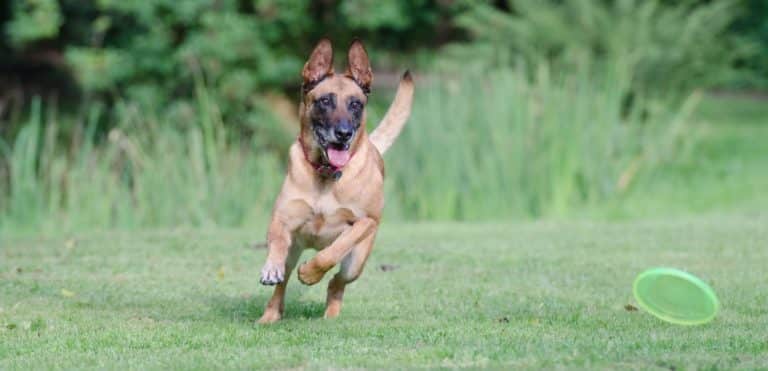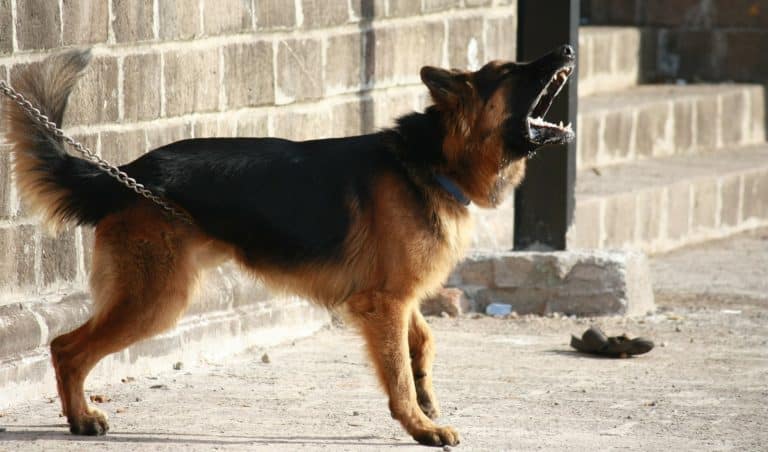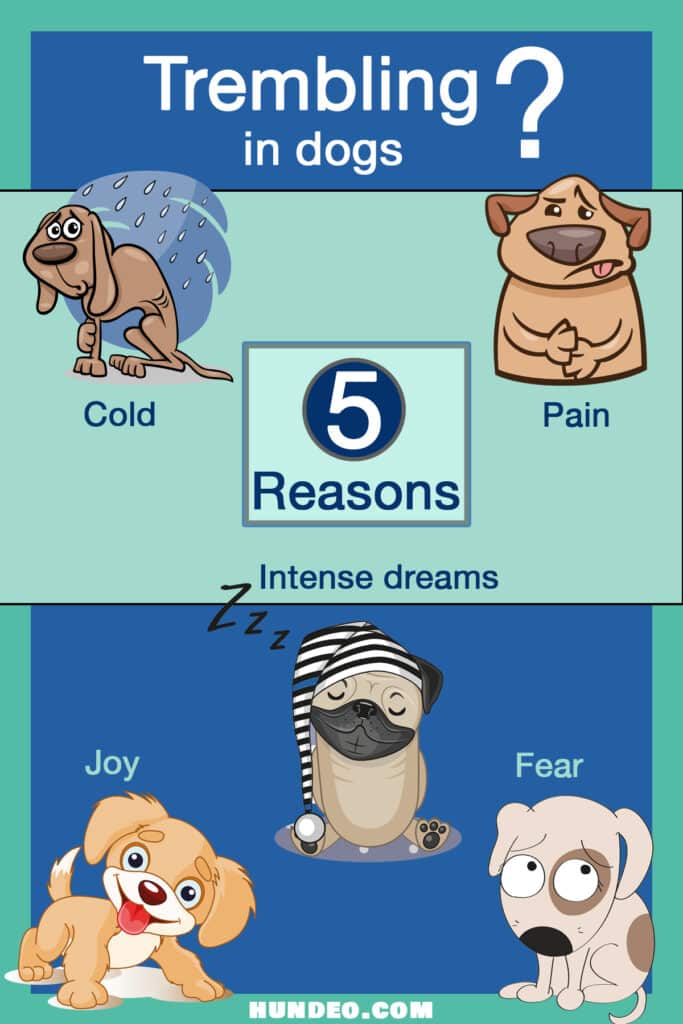13 Reasons Why Your Dog Shakes (And What You Can Do About It)
- Veterinarian Mag.med.vet. Emin Jasarevic
- Updated: 2024-02-06
Your dog is shaking? This can have many causes. I will show you 13 possible reasons for trembling dogs and how you can find the right cause yourself. In addition, you will get helpful tips to help your protégé in an emergency. In addition, we have for this article advice from the veterinarian Mag.med.vet. Emin Jasarevic for this article.

Often the trembling in your dog passes quickly. However, you should be aware that behind the trembling can hide a serious cause.
1. muscle tremor after movement

There is a natural reflex in dogs that triggers trembling. After a long walk or a lot of activity in the garden, your pet may tremble in their sleep.
This trembling and twitching can be observed in puppies from the sixth day of life. However, this is no cause for concern. These movements during resting phases serve to relax the muscles and reduce stress. It is therefore a natural mechanism for regeneration.
But also in the waking state it can come after much movement with your pelt-nose temporarily approaching muscle twitching. Intense strain and great exertion are the central triggers here.
Does your pet experience muscle twitching after a walk for a longer period of time? Then you should seek advice from a veterinarian.
2. intense dreams

After an eventful day, your darling may also have particularly intense dreams. This can also lead to twitching, but is just as harmless. Shivering during sleep serves to process experiences.
3. cold

Muscle tremors also serve to raise body temperature, among other things.
The body size of the dog plays a central role here. Small four-legged friends freeze much faster than their larger counterparts. In addition, naked dogs, but also dogs without undercoat tend to shiver quickly.
Similar to humans, hypothermia can lead to a cold in fur wearers. If your pet is very susceptible to the cold, you can put a dog coat on him for a walk. With such a coat, your little one won't freeze even at low temperatures.
A classic example of dogs that shiver quickly are Chihuahuas. It is not uncommon for them to shiver and shiver from the cold.
4. age

As your hairy companion ages, he may also be prone to spontaneous muscle twitching. This is usually a sign of Osteoarthritis. Even quadrupeds become 'decrepit' with age.
5. Fear

A tremor due to fear can be detected by body language. In this case, your pet shows the following typical postures:
- Crouched body
- Ears laid
- Tail between legs
- Growling, baring of teeth (in extreme cases)
Small dogs are usually more fearful than large ones. Because the world looks more threatening for small furry noses and the fear for survival is greater.
Anxiety situations can be triggered in dogs by an unfamiliar situation, a strange conspecific or a stranger. In these cases, you should try to get your four-legged friend back into a familiar and safe environment as quickly as possible. Remain calm and composed, so that you let your faithful friend know that everything is okay.
Poorly socialized dogs often show causeless anxiety even in adulthood. As socialization begins in puppyhood, you should familiarize your puppy with potentially worrying situations at an early age. Contact with unfamiliar people and dogs is an essential step in this process.
Unexpected noises and car traffic in particular should also not get to your pet.
If your puppy already comes into contact with such scenarios during the imprinting phase, he will be more likely to keep calm in avoidable stressful situations later on. Up to the 20th week of life, the little ones learn particularly quickly.
A dog can also learn to be afraid.
There is also so-called 'trained' fear. Many dog owners unconsciously train their four-legged friend to be fearful. When there are signs of fear, the owner often comforts their pet. Attempts are made to calm and stroke the dog, which is upset and trembling with fear.
However, this reaction of the human makes the situation worse for his darling. With the caring affection, the dog owner signals to his companion that the fear has been justified. Unintentionally, the dog is only strengthened in his panic.
In this situation, it is much better to maintain composure and appear in a good mood and confident. Your four-legged friend is oriented to its owner. If you do not send any sign of fear and danger, then your furry companion will soon calm down by itself.
6. joy

Pets can also tremble with joy. Positive excitement can cause your four-legged friend to go into an intense frenzy of joy. This state is accompanied by tail wagging, barking and even hopping, jumping and prancing. If your pet receives a lot of positive attention in the form of intense petting or treats, they may tremble.
However, it is possible that he has learned in the past to receive a treat or a stroke when he trembles. In this case, it may be a case of 'artificial trembling', so to speak, which your rascal is cleverly using for his own interests.
7. neurological diseases such as epilepsy
8. Gastric torsion
In gastric torsion, the animal's stomach twists once around its own longitudinal axis. Large quadrupeds exhibit this phenomenon significantly more often than small ones.
Dog breeds that are particularly affected include Irish Setters, Great Danes and Dobermans.
Gastric torsion can quickly become fatal if left untreated. There is severe pain and shock. Furthermore, quadrupeds with gastric torsion often exhibit a bloated belly, circulatory problems and restlessness. Many dogs gag without being able to vomit anything.
A deep chest or a loose holding apparatus of the stomach are risk factors that can lead to gastric torsion. Swallowed air or stress are also suspected to cause gastric torsion.
At the first sign, you should take your pet to the vet immediately.
9. distemper
Canine distemper is a rare but dangerous viral disease. Today, four-legged friends can be vaccinated against it.
Canine distemper can cause seizures and damage to the brain. Possible accompanying symptoms include diarrhea, vomiting, shortness of breath, fever, loss of appetite, nasal discharge, paralysis, coughing and some symptoms more.
Predominantly the nervous system, the respiratory tract and the gastrointestinal tract of your pet are attacked. Other animals such as foxes, wolves, martens, seals, otters or raccoons can also contract distemper.
The disease is transmitted mainly through the excrement or saliva of infected animals and is often fatal. You should have your furry friend examined by a veterinarian as soon as possible.
10. white dog shaker syndrome

This is a very curious hereditary disease. As the name suggests, white dog shaking syndrome only occurs in white-coated dogs. West Highland White Terriers, Poodles and Maltese are particularly affected.
In this disease, the dog trembles all over and becomes increasingly disoriented. Rapid eye movements are particularly striking. This is a neurological disease that still raises many questions.
White dog shaker syndrome is treated with medication. Sometimes the symptoms disappear after treatment. However, sometimes lifelong treatment is necessary.
11. Poisoning

Poisoning can attack your charge's entire body. Possible side effects are:
- Diarrhea
- Vomiting
- Abdominal cramps
- Fever
- Strong salivation
- Cardiovascular complaints
- Shortness of breath, restlessness, and blood in the feces and vomit.
Poisonous wild plants, but also foods that are intended for humans, can cause symptoms of poisoning in the four-legged friends. Among the foods that your pet should never eat are grapes, chocolate, onions, sweeteners and alcohol.
You can find out more in our article "What dogs can not eat“
It is recommended to let the dog walk on a leash in the dark and train commands like "come here" or "off". This is to prevent your protégé from eating something harmful uncontrollably.
If there are signs of poisoning, you should take your furry friend to the vet as soon as possible.
12. kidney failure & brain diseases
Kidney failure is accompanied by symptoms such as vomiting, diarrhea and apathy. During this time, tremors may also become more frequent.
Neurological diseases can also trigger tremors in four-legged friends. Brain strokes, strokes, heat strokes, brain trauma and various coordination disorders can also occur in dogs.
For many diseases, the risk increases with age.
13. general pain

Any form of pain can cause your pet to tremble. This is particularly the case with abdominal pain. If your pet also suffers from diarrhea, vomiting, fever, weakness or apathy in addition to tremors, a visit to the vet is necessary as soon as possible.
It is also important to distinguish between tremors and cramps:
During a seizure, your dog is absent and no longer in control of his body. Convulsions can last up to several minutes. During the convulsion, however, your furry friend is still responsive and tries to look his owner in the eye.

Frequently Asked Questions
There are many different causes of tremors in dogs. These can be harmless, like excitement or intense dreams. On the other hand, trembling can also indicate illness or poisoning.
Dogs can dream, just like humans. If these dreams are particularly intense and real for your dog, then it is normal that he can twitch in his sleep.
The best way to find out is to use the elimination method. Go through all the points in this article and try to find out what applies to your dog.
Mainly, the muscles of both humans and dogs tremble to warm up the body again in cold weather or to maintain the body temperature. For other causes, such as poisoning, the shivering has no function.
Tremors are produced by rhythmic muscle contractions of opposing pairs of muscles. These contractions take place throughout the body and serve in principle to generate heat.
Veterinarian’s Recommendation
So it's not always easy to find the right cause for your dog's trembling. In the vast majority of cases, it won't be anything bad.
Against trembling due to anxiety or cramps, I can recommend CBD oil with a clear conscience. More about this oil you can find in our big guide to CBD and its effect.
However, it can also be a serious matter that you should observe more closely. If in doubt, always go to the vet!

I am a veterinarian and writer on animal health topics. Animals are my passion, and it is my personal goal to create medically accurate articles and videos to educate pet owners as much as possible.
Share Now:

